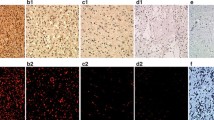Abstract
Although histopathological diagnosis of spinal cord astrocytomas is important for postoperative treatment planning and prognosis, there is a lack of reliable immunohistochemical markers. The purpose of our study was to assess the expression pattern of GFAP-δ in spinal cord astrocytomas in human patients and to evaluate the utility of GFAP-δ as an immunohistochemical diagnostic marker. A total of 22 patients with spinal cord astrocytic tumors were included in this study. Patients were classified according to the WHO designation of human astrocytic tumors; three patients had grade 1 astrocytomas, 14 had grade 2, and five had Grade 3. Normal control spinal cord tissues were obtained at autopsy from the cervical spinal cords of ten patients with no history of cervical trauma or neurological disease. We evaluated BRAF, IDH1, GFAP, and GFAP-δ immunoreactivity in control tissues and astrocytomas. In normal control tissues, GFAP immunoreactivity was detected in astrocytes whereas GFAP-δ immunoreactivity was observed in very few astrocytes adjacent to the subpial layer of the spinal cord. GFAP-δ immunoreactivity was significantly correlated with spinal cord astrocytoma grade in astrocytomas compared to that in normal control tissues. The optical density of GFAP-δ increased significantly with astrocytoma grade (correlation coefficient, R 2 = 0.680). Also, BRAF and IDH1 immunoreactivity were detected in astrocytoma. We suggest that GFAP-δ may be an additional, reliable histopathological diagnostic marker for spinal cord astrocytomas.





Similar content being viewed by others
Abbreviations
- GFAP-δ:
-
Human glial fibrillary acidic protein-delta
- BRAF:
-
Human v-raf murine sarcoma viral oncogene homolog B1 gene
- IDH1:
-
Human cytosolic NADP+ dependent isocitrate dehydrogenase 1
- WHO:
-
World Health Organization
- PBS:
-
Phosphate-buffered saline
- aa:
-
Amino acid
References
Henson JW (2001) Spinal cord gliomas. Curr Opin Neurol 14:679–682
Minehan KJ, Brown PD, Scheithauer BW, Krauss WE, Wright MP (2009) Prognosis and treatment of spinal cord astrocytoma. Inter J Radiat Oncol Biol Phys 73:727–733
Benes V, Barsa P, Suchomel P (2009) Prognostic factors in intramedullary astrocytomas: a literature review. Eur Spine J 18:1397–1422
Garcs-Ambrossi GL, McGirt MJ, Mehta VA, Sciubba DM, Witham TF, Bydon A, Wolinksy J, Jallo GI, Gokaslan ZL (2009) Factors associated with progression-free survival and long-term neurological outcome after resection of intramedullary spinal cord tumors: analysis of 101 consecutive cases. J Neurosurg Spine 11:591–599
Nakamura M, Shimada K, Ishida E, Nakase H, Konishi N (2007) Genetic analysis to complement histopathological diagnosis of brain tumors. Histol Histopathol 22:327–335
Choi K, Kwak S, Kim J, Sheen SH, Kang T (2009) Enhanced glial fibrillary acidic protein-delta expression in human astrocytic tumor. Neuroscie Lett 463:182–187
Figarella Branger D, Maues de Paula A, Colin C, Bouvier C (2011) Histomolecular classification of adult diffuse gliomas: the diagnostic value of immunohistochemical markers. Rev Neurol 167:683–690
von Deimling A, Korshunov A, Hartmann C (2011) The next generation of glioma biomarkers: MGMT methylation, BRAF fusions and IDH1 mutations. Brain Pathol 21:74–87
Hol EM, Roelofs RF, Moraal E, Sonnemans MAF, Sluijs JA, Proper EA, de Graan PNE, Fischer DF, van Leeuwen FW (2003) Neuronal expression of GFAP in patients with Alzheimer pathology and identification of novel GFAP splice forms. Mol Psychiatry 8:786–796
Roelofs RF, Fischer DF, Houtman SH, Sluijs JA, Van Haren W, Van Leeuwen FW, Hol EM (2005) Adult human subventricular, subgranular, and subpial zones contain astrocytes with a specialized intermediate filament cytoskeleton. Glia 52:289–300
Perng M, Wen S, Gibbon T, Middeldorp J, Sluijs J, Hol EM, Quinlan RA (2008) Glial fibrillary acidic protein filaments can tolerate the incorporation of assembly-compromised GFAP-delta, but with consequences for filament organization and alphaB-crystallin association. Mol Biol of Cell 19:4521–4533
Yang P, Baker KA, Hagg T (2005) A disintegrin and metalloprotease 21 (ADAM21) is associated with neurogenesis and axonal growth in developing and adult rodent CNS. J Comp Neurol 490:163–179
Constantini S, Houten J, Miller DC, Freed D, Ozek MM, Rorke LB, Allen JC, Epstein FJ (1996) Intramedullary spinal cord tumors in children under the age of 3 years. J Neurosurg 85:1036–1043
McComb RD, Burger PC (1985) Pathologic analysis of primary brain tumors. Neurol Clin 3:711–728
Korshunov A, Meyer J, Capper D, Christians A, Remke M, Witt H, Pfister S, von Deimling A, Hartmann C (2009) Combined molecular analysis of BRAF and IDH1 distinguishes pilocytic astrocytoma from diffuse astrocytoma. Acta Neuropathol 118:401–405
Martinian L, Boer K, Middeldorp J, Hol EM, Sisodiya SM, Squier W, Aronica E, Thom M (2009) Expression patterns of glial fibrillary acidic protein (GFAP)-delta in epilepsy-associated lesional pathologies. Neuropathol Appl Neurobiol 35:394–405
Acknowledgments
This study was supported by the BioGreen21 Program (200810FTH010103002 and 200810FTH010102001) of the Rural Development Administration.
Conflict of interest
None.
Author information
Authors and Affiliations
Corresponding author
Additional information
Dong Hwa Heo and Se Hoon Kim contributed equally to this study.
Rights and permissions
About this article
Cite this article
Heo, D.H., Kim, S.H., Yang, KM. et al. A histopathological diagnostic marker for human spinal astrocytoma: expression of glial fibrillary acidic protein-δ. J Neurooncol 108, 45–52 (2012). https://doi.org/10.1007/s11060-012-0801-z
Received:
Accepted:
Published:
Issue Date:
DOI: https://doi.org/10.1007/s11060-012-0801-z




